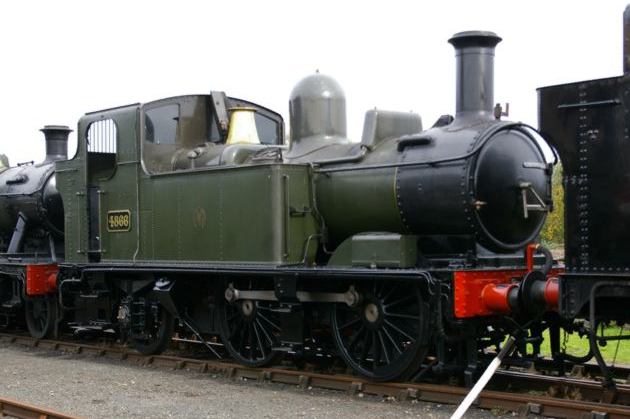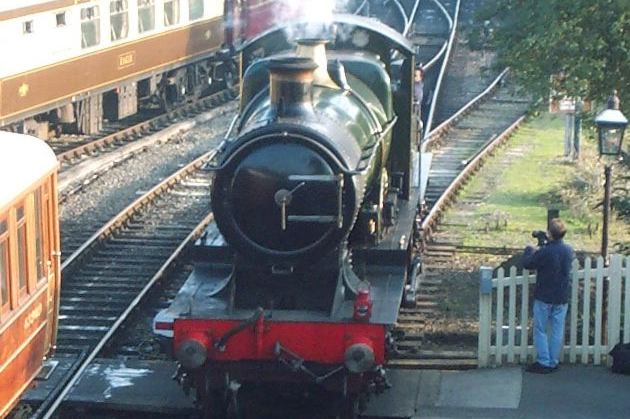A Beginners Guide to GWR Large Prairie Tank Engines
The tale of the large prairies is the most complex of the Churchward standard classes, complicated also by renumbering and gaps in the number allocation filled in by later builds. Basically they divide into Standard 2 and Standard 4 boiler variants, with a subdivision into 200psi and 225psi boilers. In the Collett era there were also some variations in wheel size, which seem to have been as much for the accountants' benefit as anything else.
K.J. Cook talks about this in one chapter of his book "Swindon Steam". In the depression of the late 20s and early 30s there was very limited money available for repairs and maintenance, but there was money available in the renewal fund for replacement locomotives. This meant that it was easier to find money to replace locomotives than repair them - if what we would now call a business case could be made. The first instance of this was when the last 10 Stars were scrapped and replaced with 10 new Castles. The new Castles, with the exception of cylinders, cabs and boilers, contained a large number of Star parts - including frames - they just happened to have lying around. The "new" Earl/Dukedog class was an even more extreme example.
In the case of the early large Prairies they were getting towards the age when new cylinders and front end extension frames were going to be required in heavy overhauls. So Collett had new variations of the classes designed with significantly increased power with the intention of using them primarily for roles where the increased power would be valuable. So a new version of the Standard 2 boiler was designed, uprated to 225psi, but with no increase in weight due to the use of high tensile nickel alloy steel, and smaller non-standard wheels of two different sizes were used to further increase tractive effort. The result was the new 6100, 3100 and 8100 classes, the last two of which were rebuilds/renewals using renewal fund money.
3100 (1903) 3111 (1905), 5100 class
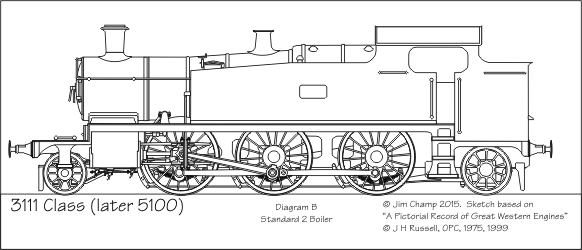
In 1903 No 99 was one of Churchward's first three standard prototypes, alongside the 4-6-0 and 2-8-0. 99 had 8'9 - 7' - 7'9 - 8'3 wheelbase with 2'5 front overhang and 3'2 rear overhang, quite small and short flat topped side tanks and 1,380 gallons water capacity, some of it in a tank in the bunker. She had a short cone Standard 2 boiler running at 195psi. 3111 - 3149 were built in three lots in 1905/6. These production engines had long cone Standard 2 boilers and larger and longer tanks with sloping tops for a total of 2,000 gallons water capacity. With a little over 18tons on the driving wheels they were red route engines as built, but well within the limit. Tractive effort was nominally 23,690 when new.
The characteristic front end struts of the 2 Cylinder classes were fitted from 1909. Apparently the extension frames were especially vulnerable when used for banking. Superheating came from 1910-1915, most by 1912, and several arrangements were tried in the early days. Boilers were uprated to 200psi from about 1912, which increased the nominal TE to 24,300.
No 99 was renumbered 3100 in the 1912 renumbering. 3101-3110 were left unused rather than renumber 3111-3149 to 3101-3139.
Coal bunkers were extended at the top in 1919-22, and rear fenders added at much the same time.
About 1927 some 31s were run with reduced weight, mainly as a result of limiting tank capacity. The tanks were then altered back to the full capacity, and the weight distribution altered for all the class, bringing more weight on the carrying wheels and bringing them within the blue route limit, but reducing the adhesive weight available for acceleration and braking. They were then renumbered in the 51xx series, keeping the same last two digits, making the class 5100 and 5111-5149. So during the conversion period 31xx were red route and 51xx blue route availability.
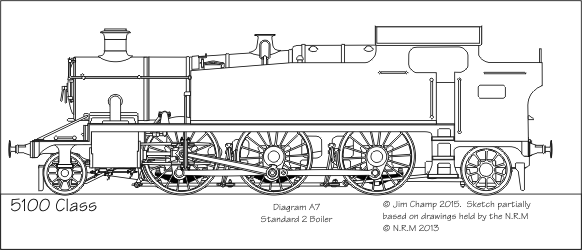
Ten, including 5100 ex 3100 ex 99 were converted to 8100 class by the time the war started, but there were no further conversions. Outside steam pipes and curved front ends appeared on some locomotives from 1943 after the conversion programme was abandoned - presumably before then those requiring new cylinders were put on the conversion programme.
3150 class
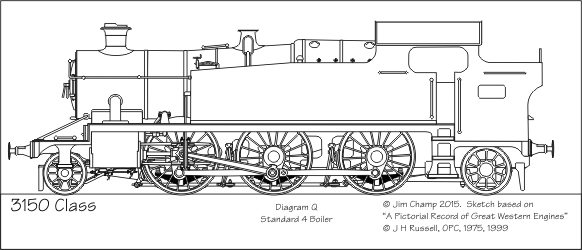
The 3150s were the second variation on the large prairie theme, having the larger Standard 4 boilers.
The "prototype" 3150 came out in 1906 and was built alongside a batch of the 3100 class. 40 production locomotives followed in 1908/9. They were, of course, quite a bit heavier than the 3100s and theoretically a little more powerful as they had slightly larger cylinders giving 25,670 TE.
They received most of the developments that their Standard 2 boilered sisters received in the same sorts of date ranges. There is no evidence that changes to the weight distribution were considered in the 1930s.
The front end struts appeared first on this class about 1907, but later became universal on all the 2 cylinder classes.
Later photographs suggest they were all fitted with the brake rigging inside the wheels, unlike the 3111/5111 series. Outside steam pipes and curved front end frames started to be fitted from 1934, and a few had outside steam pipes but retained the straight framed front end.
Five were withdrawn before the war for reconstruction as the new smaller wheeled Collett 3100 class (see below).
5101 class
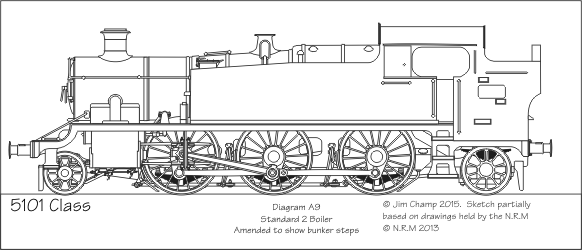
The 5101s were effectively more batches of the original 3100 class, but built with the various design improvements that had been made in the meantime. 5101-10 were built in 1929, filling in the gap in the number sequence of the Churchward 3100 class (now numbered in the 51xx series) followed by 5150-5189 in 1930/31. 5190-5199 and 4100-4139 came between 1934 and1939, and finally 4140-4179 from 1946 to 1949, the last leaving the works as British Railways locomotives.
They had 200psi Standard 2 boilers, curved front end frames, outside steam pipes, the later style small flanged motion plates and a new cab design with roof and sides integrated. They had prominent external sandboxes under the cab, unlike the Churchward batches.
6100 class
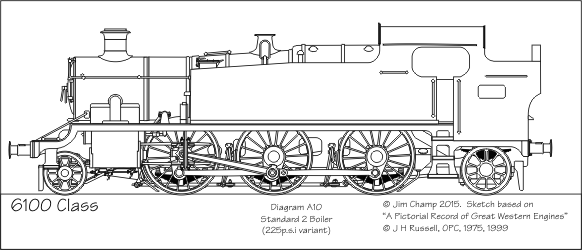
These were effectively a 5101 development, using the nickel steel 225psi version of the Standard 2 boiler. This made for a more powerful locomotive with a tractive effort of 27,340. The intention seems to have been faster acceleration. They were intended and used for London suburban services, and fitted with a trip cock for working on London Underground tracks.
60 were built between 1931 and 1933, and then another ten in 1935. Externally they were not readily distinguishable from the 5101 class.
6116 was rebuilt with smaller wheels, presumably serving as a kind of prototype for the 8100 rebuilds, and retained these for the rest of her life.
8100 class
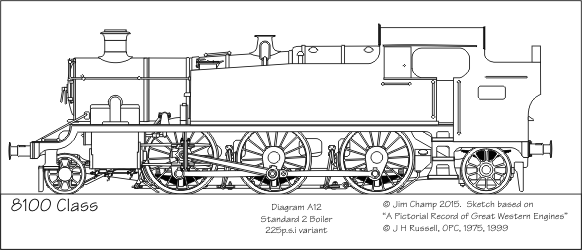
The 8100s were 3111/5100s rebuilt with 225 psi Standard 2 boilers and 5'6 wheels. This brought the nominal tractive effort to 28,165. They could be regarded as a smaller wheeled version of the 6100s.
At one stage there was a plan to rebuild all the original 3111s as 8100, and probably 5101-10 too, but the war put an end to it.
3100 (1938) class
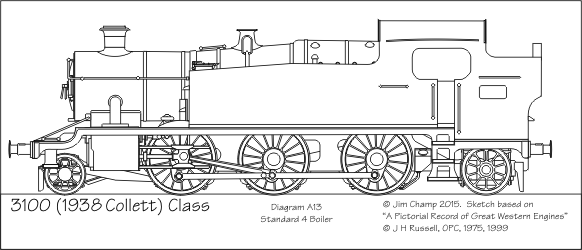
These were intended to be principally banking locomotives. They were reconstructions of the 3150 class, and in the same way that the 8100s were 3111/5100s upgraded with smaller wheels and a higher pressure boiler these were upgrades of the 3150s. Withdrawn 3150s were given smaller (5'3) wheels, new curved frame front ends and new Standard 4 boilers set to 225psi. They were much the most powerful of the large prairies with a tractive effort of 31,170.
